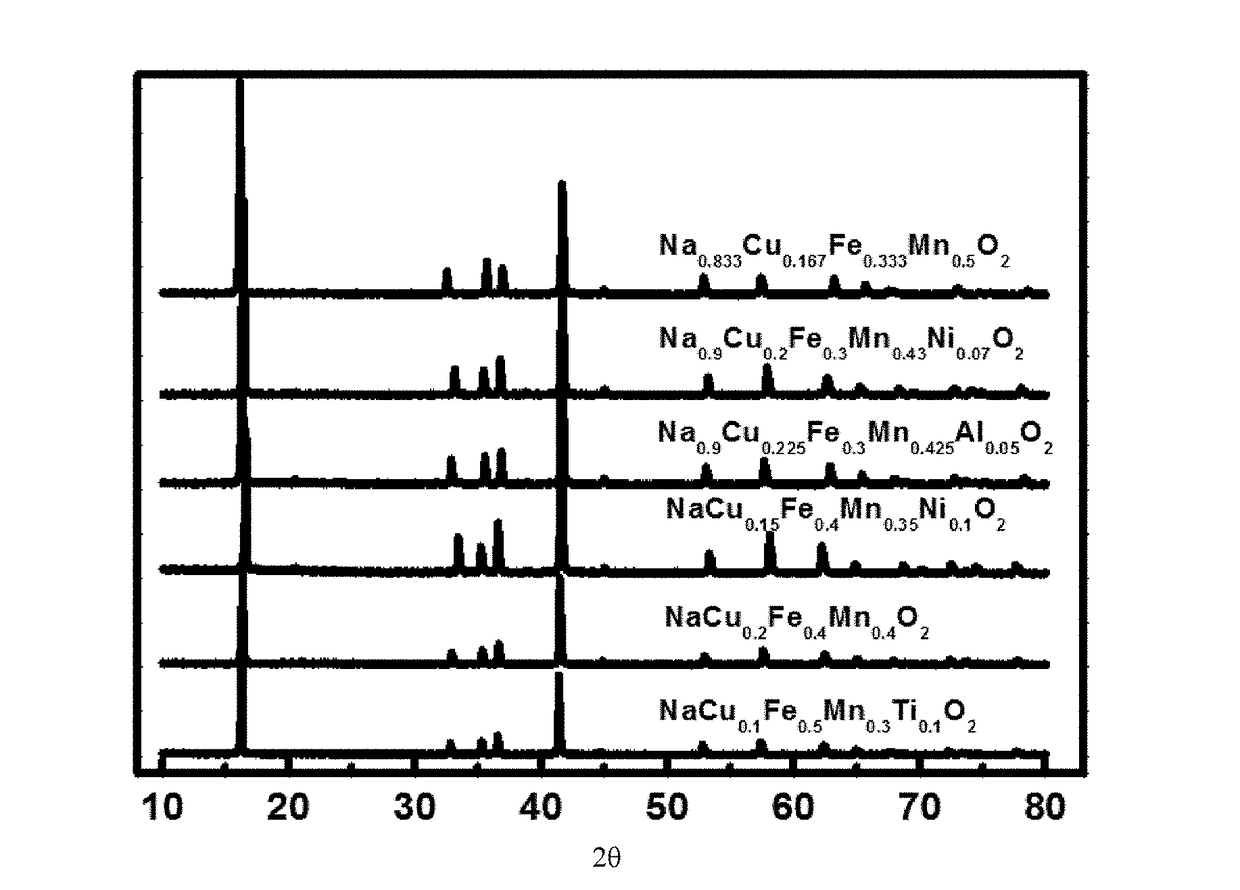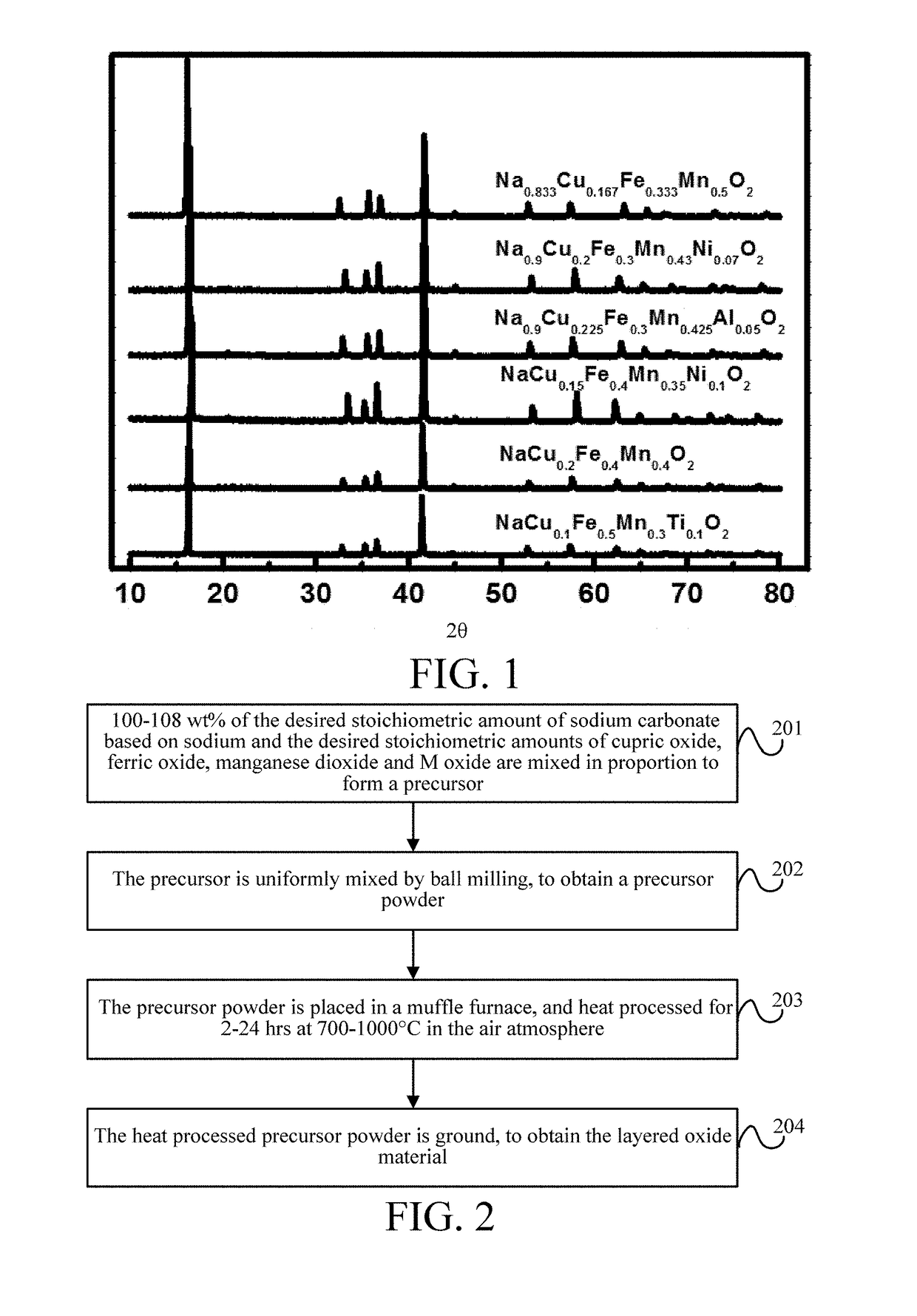Layered oxide material, preparation method, electrode plate, secondary battery and use
a technology of layered oxide and secondary batteries, applied in the field of material technologies, can solve the problems of low sodium-ion battery cost, low preparation cost, high cost of lithium-ion batteries, etc., and achieve the effects of high charge capacity, low preparation cost and high abundance in the earth's crus
- Summary
- Abstract
- Description
- Claims
- Application Information
AI Technical Summary
Benefits of technology
Problems solved by technology
Method used
Image
Examples
embodiment 1
[0077
[0078]Embodiment 1 of the present invention provides a layered oxide material having a general chemical formula NaxCuiFejMnkMyO2+β;
[0079]where M is an element that is doped for replacing the transition metals, and is specifically one or more Li+, Ni2+, Mg2+, Mn2+, Zn2+, Co2+, Ca2+, Ba2+, Sr2+, Mn3+, Al3+, B3+, Cr3+, Co3+, V3+, Zr4+, Ti4+, Sn4+, V4+, Mo4+, Mo5+, Ru4+, Nb5+, Si4+, Sb5+, Nb5+, Mo6+, and Te6+; and
[0080]x, y, i, j, k, and β are respectively the molar ratios of respective elements, provided that x, y, i, j, k, and β satisfy the relations: y+i+j+k=1, and x+my+2i+3j+4k=2(2+β), where 0.8≦x≦1, 0<i≦0.3; 0<j≦0.5, 0<k≦0.5, −0.02≦β≦0.02, and m is the valence of M.
[0081]The layered oxide material has a space group of R3m.
[0082]FIG. 1 is an X-ray diffraction (XRD) pattern of a plurality of layered oxide materials having different molar percentages of elements. It can be seen from the XRD pattern that NaxCuiFejMnkMyO2+β provided in this embodiment is an oxide having a layered-s...
embodiment 2
[0084
[0085]This embodiment provides a method for preparing a layered oxide material, which is specifically a solid-state reaction, and includes the following steps as shown in FIG. 2.
[0086]Step 201—100-108 wt % of the desired stoichiometric amount of sodium carbonate based on sodium and the desired stoichiometric amounts of cupric oxide, ferric oxide, manganese dioxide and M oxide are mixed in proportion to form a precursor.
[0087]Specifically, M is one or more of Li+, Ni2+, Mg2+, Mn2+, Zn2+, Co2+, Ca2+, Ba2+, Sr2+, Mn3+, Al3+, B3+, Cr3+, Co3+, V3+, Zr4+, Ti4+, Sn4+, V4+, Mo4+, Mo5+, Ru5+, Nb5+, Si4+, Sb5+, Nb5+, Mo6+, and Te6+.
[0088]Step 202—The precursor is uniformly mixed by ball milling, to obtain a precursor powder.
[0089]Step 203—The precursor powder is placed in a muffle furnace, and heated for 2-24 hrs at 700-1000° C. in the air atmosphere.
[0090]Step 204—The heated precursor powder is ground, to obtain the layered oxide material.
[0091]The method for preparing a layered oxide m...
embodiment 3
[0092
[0093]This embodiment provides a method for preparing a layered oxide material, which is specifically spray drying, and includes the following steps as shown in FIG. 3.
[0094]Step 301—100-108 wt % of the desired stoichiometric amount of sodium carbonate based on sodium, and cupric oxide, ferric oxide, manganese dioxide and M oxide are weighed and mixed in proportion to form a precursor. Alternatively, sodium nitrate, cupric nitrate, ferric nitrate, manganese acetate and M nitrate at stoichiometric ratios are used as a precursor
[0095]Specifically, M may be one or more of Li+, Ni2+, Mg2+, Mn2+, Zn2+, Co2+, Ca2+, Ba2+, Sr2+, Mn3+, Al3+, B3+, Cr3+, Co3+, V3+, Zr4+, Ti4+, Sn4+, V4+, Mo4+, Mo5+, Ru5+, Nb5+, Si4+, Sb5+, Nb5+, Mo6+, and Te6+.
[0096]Step 302—Ethanol or water is added to the precursor, and stirred until uniform, to form a slurry.
[0097]Step 303—The slurry is subjected to spray drying, to obtain a precursor powder.
[0098]Step 304—The precursor powder is placed in a muffle fur...
PUM
| Property | Measurement | Unit |
|---|---|---|
| specific energy | aaaaa | aaaaa |
| coulombic efficiency | aaaaa | aaaaa |
| particle size distribution | aaaaa | aaaaa |
Abstract
Description
Claims
Application Information
 Login to View More
Login to View More - R&D
- Intellectual Property
- Life Sciences
- Materials
- Tech Scout
- Unparalleled Data Quality
- Higher Quality Content
- 60% Fewer Hallucinations
Browse by: Latest US Patents, China's latest patents, Technical Efficacy Thesaurus, Application Domain, Technology Topic, Popular Technical Reports.
© 2025 PatSnap. All rights reserved.Legal|Privacy policy|Modern Slavery Act Transparency Statement|Sitemap|About US| Contact US: help@patsnap.com



